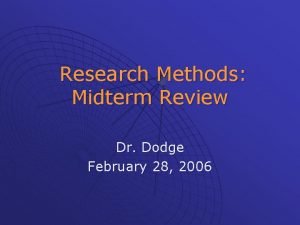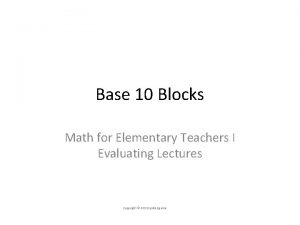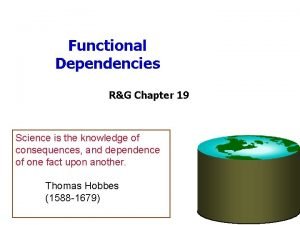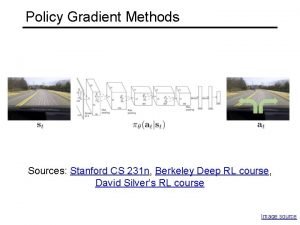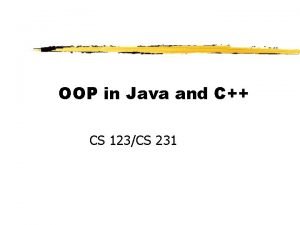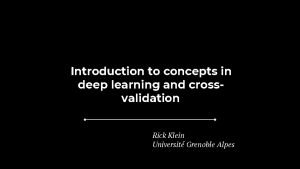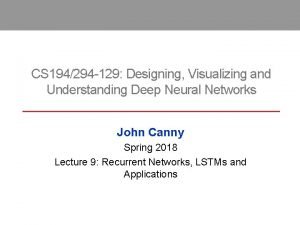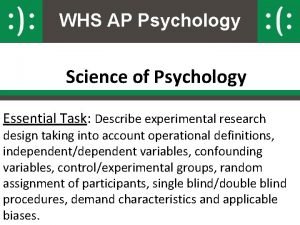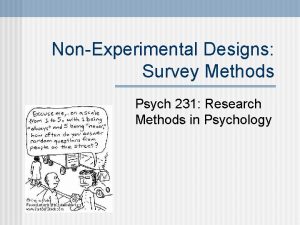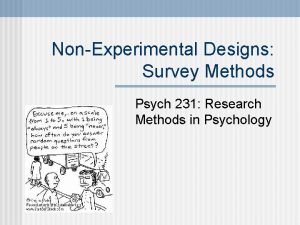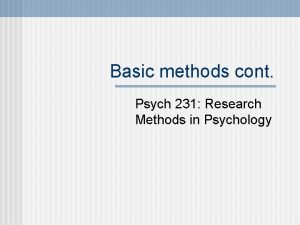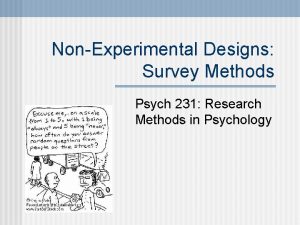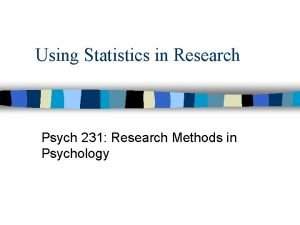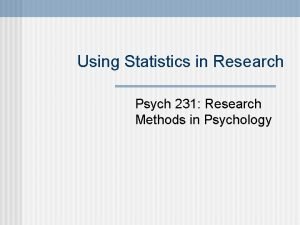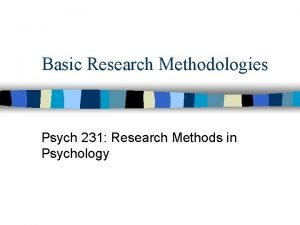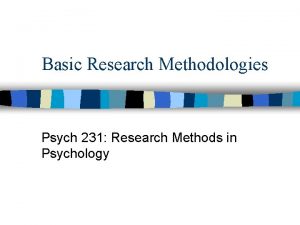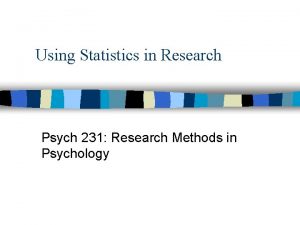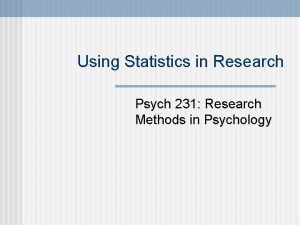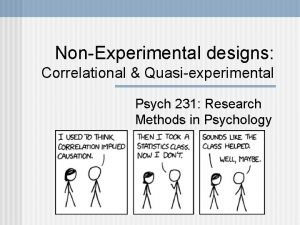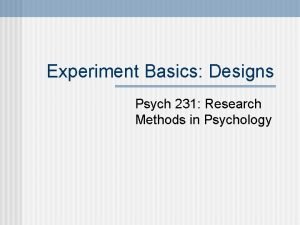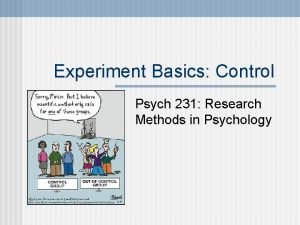Review for Exam 2 Psych 231 Research Methods






























- Slides: 30

Review for Exam 2 Psych 231: Research Methods in Psychology

Review session Thursday Oct 26 in De. Garmo 406 @ 8: 00 (PM) Review Session (Andrew & Charles)

n APA style n n n Underlying reasons for the organization Parts of a manuscript Variables Sampling Control Experimental Designs n n n Vocabulary Between & Within Factorial designs Exam 2 Topics

n Purpose of presenting your research n n To get the work out there, to spur further research, replication, testing/falsifaction of your theory Why the structured format? n Clairity: To ease communication of what was done • Forces a minimal amount of information • Provides consistent format within a discipline • Allows readers to cross-reference your sources easily n See Chapter 16 of your textbook APA style

§ Title Page § Abstract § Body § § § § § Introduction & Literature review Methods Results Discussion (& Conclusions) References Authors Notes Footnotes Tables Figure Captions Figures Parts of a research report

Short title – goes in header (with page number) on each page of the manuscript Running head – will go on each page of published article, no more than 50 characters –Title should be maximally informative while short (10 to 12 words recommended) Order of Authorship sometimes carries meaning Affiliation – where the bulk of the research was done Title Page

n Abstract n short summary of entire paper • • • 100 to 120 words the problem/issue the method the results the major conclusions Abstract

§ Introduction § Background, Literature Review, Statement of purpose, Specific hypotheses § Methods (in enough detail that the reader can replicate the study) § Participants § Design § Apparatus/Materials § Procedure § Results (state the results but don’t interpret them here) § Verbal statement of results § Refer to Tables and figures § Statistical Outcomes § Discussion (interpret the results) § Relationship between purpose and results § Theoretical (or methodological) contribution § Implications Body

n n Author’s name Year Title of work Publication information • Journal/Book Title • Issue • Pages References

n Characteristics of the situation n Variables • Levels • Conceptual variables (constructs) • Operationalized variables • Underlying assumptions • Types • Independent variables (explanatory) • Dependent variables (response) • Extraneous variables • Control variables • Random variables • Confound variables Variables

n The variables that are manipulated by the experimenter n n n Each IV must have at least two levels Combination of all the levels of all of the IVs results in the different conditions in an experiment Methods of manipulation n Straightforward manipulations • Stimulus manipulation • Instructional manipulation n Staged manipulations • Event manipulation n Subject manipulations Independent variables

n n Choosing the right range Things to watch out for n n Demand characteristics Experimenter bias Reactivity Ceiling and floor effects Independent variables

n The variables that are measured by the experimenter n n They are “dependent” on the independent variables (if there is a relationship between the IV and DV as the hypothesis predicts). How to measure your construct: n Can the participant provide self-report? • Introspection • Rating scales n Is the dependent variable directly observable? • Choice/decision (sometimes timed) n Is the dependent variable indirectly observable? • Physiological measures (e. g. GSR, heart rate) • Behavioral measures (e. g. speed, accuracy) Dependent variables

n Measuring n Scales of measurement • • n Nominal Ordinal Interval Ratio Errors • • Validity Reliability Sampling Error Bias Dependent variables

n Do you get the same score with repeated measurement? n n n Test-restest reliability Internal consistency reliability Inter-rater reliability Reliability

n Does your measure really measure what it is supposed to measure? n There are many “kinds” of validity • Construct • Face • Internal • Threats • • • History Maturation Selection Mortality Testing • External • Variable representativeness • Subject representativeness • Setting representativeness Validity

n Typically we don’t test everybody n n n Population Sample Goals: n Maximize: • Representativeness - to what extent do the characteristics of those in the sample reflect those in the population n Reduce: • Bias - a systematic difference between those in the sample and those in the population n Types n Probability sampling • Simple random sampling • Systematic sampling • Cluster sampling Sampling Non-probability sampling • • Convenience sampling Quota sampling

n Types n Control variables • Holding things constant - Controls for excessive random variability n Random variables – may freely vary, to spread variability equally across all experimental conditions • Randomization n Confound variables • Other variables, that haven’t been accounted for (manipulated, measured, randomized, controlled) that can impact changes in the dependent variable(s) Extraneous Variables

n Sources of Total (T) Variability: T = NRexp + NRother +R NR oth er NR ex p R NR oth er n Our goal is to reduce R and NRother so that we can detect NRexp. n That is, so we can see the changes in the DV that are due to the changes in the independent variable(s). Experimental Control R

n Methods of control n n Comparison Production (picking levels) Constancy/Randomization Problems n n n Excessive random variability: Confounding Dissimulation Experimental Control

n Some vocabulary n n n n Factors Levels Conditions Within groups Between groups Control group Single factor designs Factorial designs • Main effects • Interactions Experimental designs

n Advantages: n n Simple, relatively easy to interpret the results Is the independent variable worth studying? • If no effect, then usually don’t bother with a more complex design n Sometimes two levels is all you need • One theory predicts one pattern and another predicts a different pattern n Disadvantages: n “True” shape of the function is hard to see • Interpolation • Extrapolation 1 Factor - 2 -level experiments

n Advantages n n Get a better idea of the true function of the relationship Disadvantages n n Needs more resources (participants and/or stimuli) Requires more complex statistical analysis (analysis of variance and pair-wise comparisons) 1 Factor - Multi-level experiments

n Between subjects designs n n Each participant participates in one-and-only-one condition of the experiment. Within subjects designs n all participants participate in all of the conditions of the experiment. Between & Within Subjects Designs

n Advantages: n Independence of groups (levels of the IV) • Harder to guess what the experiment is about without experiencing the other levels of IV • exposure to different levels of the independent variable(s) cannot “contaminate” the dependent variable • No order effects to worry about • Counterbalancing is not required • Sometimes this is a ‘must, ’ because you can’t reverse the effects of prior exposure to other levels of the IV n Disadvantages n Individual differences between the people in the groups • Non-Equivalent groups • Excessive variability Between subjects designs

n Advantages: n Don’t have to worry about individual differences • Same people in all the conditions • Variability between groups is smaller (statistical advantage) n n Fewer participants are required Disadvantages n Order effects: • Carry-over effects • Progressive error • Counterbalancing is probably necessary n Range effects Within subjects designs

n Two or more factors n n Factors - independent variables Levels - the levels of your independent variables • 2 x 4 design means two independent variables, one with 2 levels and one with 4 levels • Calculate # of “conditions” by multiplying the levels, a 2 x 4 design has 8 different conditions n n Main effects - the effects of your independent variables ignoring (collapsed across) the other independent variables Interaction effects - how your independent variables affect each other • Example: 2 x 2 design, factors A and B • Interaction: • At A 1, B 1 is bigger than B 2 • At A 2, B 1 and B 2 don’t differ Factorial experiments B 1 A 2 B 3 B 4

A 1 A 2 B 1 mean B 2 mean A 1 mean A 2 mean Main effect of A 2 x 2 factorial design Marginal means Main effect of B

n So there are lots of different potential outcomes: • A = main effect of factor A • B = main effect of factor B • AB = interaction of A and B • With 2 factors there are 8 basic possible patterns of results: • • 1) No effects at all 2) A only 3) B only 4) AB only • • 5) A & B 6) A & AB 7) B & AB 8) A & B & AB Factorial experiments

n Advantages n – – n Interaction effects – One should always consider the interaction effects before trying to interpret the main effects Adding factors decreases the variability – Because you’re controlling more of the variables that influence the dependent variable – This increases the statistical Power of the statistical tests Increases generalizability of the results – Because you have a situation closer to the real world (where all sorts of variables are interacting) Disadvantages n n n Experiments become very large, and unwieldy The statistical analyses get much more complex Interpretation of the results can get hard • In particular for higher-order interactions • Higher-order interactions (when you have more than two interactions, e. g. , ABC). Factorial Designs
 Psych 101 exam 4
Psych 101 exam 4 Mt sac psych tech review
Mt sac psych tech review Midterm exam for applied research methods
Midterm exam for applied research methods Ap gov final review
Ap gov final review Wax pattern fabrication pdf
Wax pattern fabrication pdf Acf 231
Acf 231 Article 231 of the treaty of versailles
Article 231 of the treaty of versailles 132 213
132 213 Pa msu
Pa msu Decreto 231 del 2007
Decreto 231 del 2007 Hino 231 hinario novo cantico
Hino 231 hinario novo cantico Gezang 231
Gezang 231 Bbm 231
Bbm 231 Transitor
Transitor Walfisch ikegami model
Walfisch ikegami model Draw 231 with base ten blocks
Draw 231 with base ten blocks 040 231 3666
040 231 3666 Cs 231 n
Cs 231 n Standford cs231
Standford cs231 Bbm 231
Bbm 231 Pengertian berjiran
Pengertian berjiran Artical 231
Artical 231 123cs
123cs Toastmasters timer sheet pdf
Toastmasters timer sheet pdf Electrostatic energy
Electrostatic energy Electric field formula
Electric field formula Cs 231 n
Cs 231 n Cs 231 n
Cs 231 n Visualizing and understanding recurrent networks
Visualizing and understanding recurrent networks Soft vs hard attention
Soft vs hard attention Double blind procedure ap psychology
Double blind procedure ap psychology


